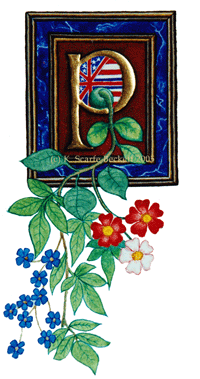Agate burnishers
Agate burnishers are lovely tools, used to create a mirror-like brilliance in gilded areas by gently but firmly rubbing the gold leaf after it's been applied and the medium has dried. This smooth, heavy polishing action on the metal surface is burnishing.
The classic (and perhaps most useful) burnisher form is probably the elbow-shaped 'bent fang', which contains both larger, flatter curved surfaces for burnishing your top layers or wider expanses of gilding, and also a narrow, rounded point for getting into corners and edges.
This shape of burnisher is also useful for burnishing shell-gold (real gold paint) after it's dry. On thick art paper, the rounded point can be used to impress a small hollow onto decorative gold dots to create a 'dew-drop' effect.
Other shapes of agate burnisher include a narrow, straight point for finishing very fine work; flat-ended cylinders for smooth gilding; broad, squashed-spoon forms for large, flat areas and the insides of right-angles; and a strange wiggly shape whose best purpose I haven't yet fully established. I bought it on special offer in an extravagant moment. It may have something to do with gilding picture frames.
Tips for using agate burnishers
Burnishing is best for traditional water-gilding onto gesso.
Whatever medium you stick your gold leaf to, as long as it is one that dries to a non-sticky finish, you can probably burnish it somewhat afterwards using an agate, but bear in mind that results will vary according to the adhesive.
I've tried it on:
PVA-based size, where burnishing works O.K. but not great. If you burnish too hard, it rubs through the gold.
Gum Ammoniac where it does not work – you lose your gilding.
Roberson's Improved Gold Body (a kind of solid, custard-like glue for raised gilding) – burnishing works pretty well so long as you're doing it in a dry atmosphere.

The best gilding medium for a burnished gold finish is supposed to be the famous gesso sottile which has a firm, dry but slightly yielding texture. Ready-to-use pva or acrylic-based gold adhesive will tend to dry slightly more rubbery and won't give quite the same high shine. Gum ammoniac gives quite a good flat shine without any furthe work, but I've given up trying to burnish it.
I haven't tried garlic juice, and I don't plan to.
Agate burnishers should glide smoothly across the gold, in what can only be described as a buttery manner. You can tell when the burnishing is going well because it feels right, and good. Equally, if the size was too wet and the leaf has sunk into it, or the size is still damp when you start burnishing, you will feel a horrible fine-grained sticking sensation, like getting smooth peanut butter under your tongue; and you will probably find a long dull streak in your gold. Don't despair: just re-gild that area (and learn for next time).
More handy tips for happier burnishing
- Make sure the gilding medium (mordant, adhesive, size, gesso etc) is fully dry before you start.
- Begin burnishing lightly, with small short motions.
- Gradually increase the pressure and speed of strokes, 'feeling your way' across the surface. (Don't be afraid to lean into it a little if the adhesive is right. Good-quality agate burnishers can take quite a few pounds of weight and this pressure is partly what polishes the gold.)
- Exploit the shape of your burnisher to address edges, corners and detail, especially on raised gilding.
- While burnishing, 'sticky means STOP'. If you feel surface reistance, grittiness, roughness or 'scrape' in the action of the burnisher on the gold, stop burnishing. (And repair the damage, usually by regilding that section and waiting until it is dry again before re-burnishing.)
Why agate burnishers? The truth is that you can probably use any very smooth, shiny, hard substance to burnish gold to some extent. (Having said that, treat steel burnishers with caution as the gold leaf may well adhere in small patches to the metal surface.)

I have read that a dog's canine tooth stoutly mounted in a handle works well. (Good luck finding a suitable specimen.) In fact, 'dog's-tooth burnisher' is still the name sometimes used to describe the most traditional shape of burnisher as seen above.
Highly-polished pieces of the semi-metallic stone haematite (or hematite in US spelling) are also used for burnishing. You may be able to find a lipstick-shaped haematite burnisher mounted in a wooden handle — I have seen them in specialist shops in the UK, and myself have a small pebble of haematite in a drawer somewhere that I've used simply gripped between fingertips.
But agate burnishers have long been used for reliable results in burnishing. Because they are hard, evenly textured and glossy, they don't scratch easily and so don't damage the thin gold leaf that they are pressed onto. They are sensitive and pleasing to use. And there is nothing more satisfying than to admire the bewitching gloss of newly burnished gold leaf on your latest piece of calligraphy.
Go to 'Gold Leafing' for more information and links
Return from 'Agate Burnishers' to the Calligraphy Skills homepage